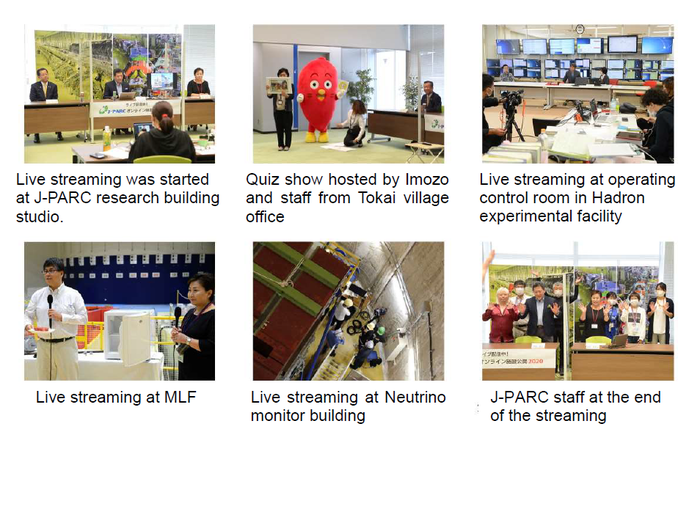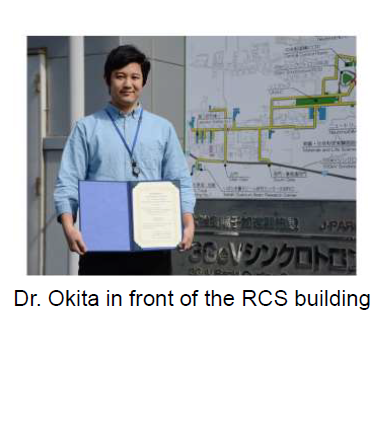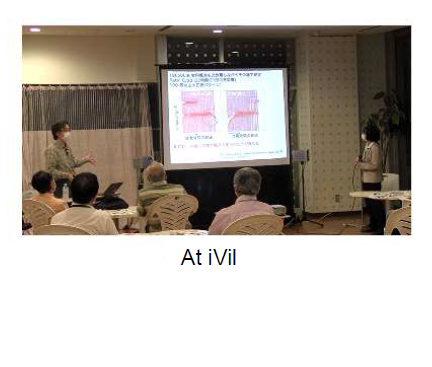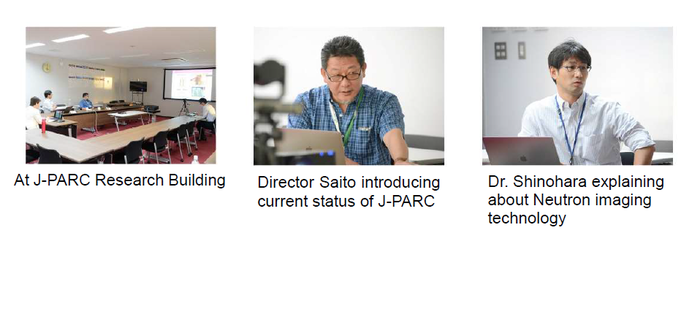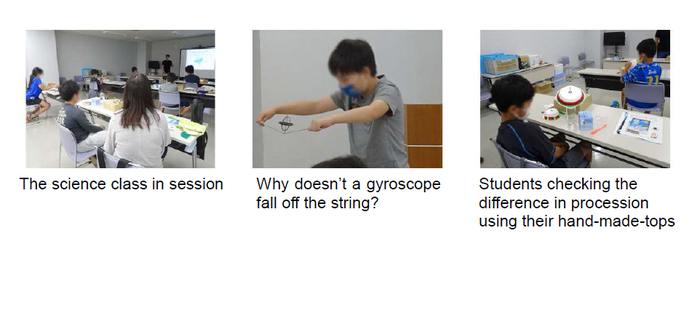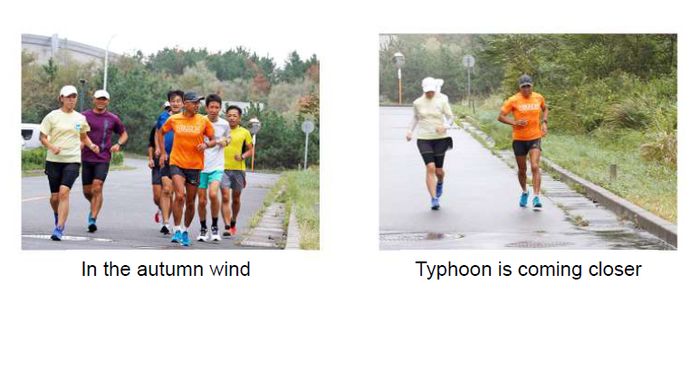J-PARC News October 2020 (Issue #186)
■ J-PARC Virtual Open House 2020 / Live streamed J-PARC Facilities (10 October) ~Visit J-PARC Online This Year!~ Thank you for watching!
Due to the current situation with coronavirus (COVID-19), we decided not to hold our annual open house this year, and instead, the public was virtually invited to the open house through the J-PARC website. The virtual open house started on October 7th, and on the 10th, it was live-streamed on YouTube. For the opening, Tokai Village Mayor Osamu Yamada and J-PARC Center Director Naohito Saito discussed the village and J-PARC. Also, Tokai Village’s official character Imozo and village staff featured a quiz on the village, which was followed by an introduction of each facility, starting with the Hadron Experimental Facility, and continuing with the Materials and Life Experimental Science Facility (MLF) and the Neutrino Monitoring Building. The researchers introduced their facilities and answered viewers’ questions. The special website for this event also featured facilities which were not included in the live streaming and instruments which can be only shown remotely. A special website for this event is now archived at our homepage.
(http://j-parc.jp/c/OPEN_HOUSE/2020/)
■ Hidefumi Okita wins Annual Meeting Award for His Poster Presentation for 17th Annual Meeting of Particle Accelerator Society of Japan (4 September)
The 17th Annual Meeting of the Particle Accelerator Society of Japan was held on September 2-4 in Matsuyama City, Ehime Prefecture. This time, it was held online due to the spread of the novel coronavirus infection. In the meeting, five excellent presenters in the oral presentation and poster presentation categories were chosen for the Annual Meeting Awards. In the poster presentation category, Hidefumi Okita, JAEA Post-Doctoral Fellow, from Accelerator Section II of the J-PARC Center received the Annual Meeting Award for his presentation, "Benchmarking of longitudinal calculation code BLonD for application to 3 GeV rapid-cycling synchrotron (RCS)." Dr. Okita confirmed that the new longitudinal beam simulation code BLonD (Beam Longitudinal Dynamics), which CERN* is developing, can be applied to evaluate beam behavior traveling in a vertical direction by being accelerated in RCS. His research was highly evaluated for confirming that the BLonD simulation, which reflects the parameters of the actual RCS beam operation at 1 MW, reproduced the beam measurements with great accuracy.
*The European Organization for Nuclear Research (CERN) is the world's largest laboratory of particle physics located across the border between Switzerland and France.
■ J-PARC Hello Science: "The Latest Battery Research at J-PARC for the Innovation of Lithium-ion Batteries" (25 September, Tokai Industry and Information Plaza "iVil")
In September’s Hello Science, Takashi Kamiyama of the Neutron Science Section gave a lecture on J-PARC's latest battery research. At first, Dr. Kamiyama introduced Dr. Akira Yoshino's lecture at the awards ceremony of the Nobel Prize in chemistry. He explained the importance of battery development for realization of a future society with vehicles and robots utilizing advanced AI. Dr. Kamiyama added that neutrons are highly effective in R&D of batteries. Taking a look back 90 years ago, when neutrons were first discovered, he explained the current status of advanced battery research with SPICA at J-PARC MLF by showing some video of experiments and data analysis. Participants gave many questions, which implied that they were highly interested in the theme.
■6th J-PARC Media Meeting held online (30 September, from J-PARC Research Building)
J-PARC held its 6th Media Meeting on Zoom. This was our new challenge in the "With Corona" era. We had nine people from seven companies participate. First, J-PARC Center Director Naohito Saito explained current status of J-PARC, and an introduction of research conducted at J-PARC followed. Neutron Science Section's Takenao Shinohara, JAEA Principal Researcher, reported "Neutron imaging technology and its Applications." He is a person in charge of the neutron imaging system RADEN, which is installed in the MLF, and explained features, devices, and application examples of the imaging system. He gave examples of non-destructive observation of the inside of materials using the neutron imaging system and in-situ observation of practical goods, for example visualization of magnetic field distribution of an operating motor. The explanation included new visualization technologies such as element selective imaging using pulsed neutrons. Topics discussed in a question and answer session at the end of the meeting included the relationship between J-PARC's particle and nuclear physics experiment Muon g-2/EDM (planned) and Fermilab's experiment in the United States (ongoing), and the significance of visualization of water in a fuel cell using neutrons.
■ J-PARC Science Class "Can World's Smallest Top Explain Nobel Prize-class Discovery?! - Accelerator research to elucidate small world using large device-" (4 October, Hitachi Civic Center Science Museum)
A science experiment class by the J-PARC Center was held at the Hitachi Civic Center Science Museum. Dr. Tsutomu Mibe of the Hadron Section, Dr. Koichiro Shimomura, Deputy Director of the MLF Division, Dr. Masashi Otani of the Accelerator Section VII, who are involved in the muon research, and Ms. Naoko Inoue of the Public Relations Section, gave lectures. Eight science-loving elementary school students responded to our message, "Let's make slightly strange tops and experiment with them. You can step into the research world of J-PARC!" They joined and carried out experiments one by one while following the instructors' explanations. In the experiment (1), using a magnetic compass, students checked the magnetic field lines generated by the movement of electrons, which was created by passing a current through a circular coil. Then the students compared the lines with the magnetic field lines of a disk magnet. In the experiment (2) to observe precession*, they experimented with a top, which they made using a styrofoam plate with an axis in the center of the plate. They observed differences in precession by spinning the top while adjusting the distance between the top's center of gravity and the fulcrum where the axis of rotation touches the table. They also experimented with a rotating gyroscope on a string and saw it never falling. The subject of this experiment was particles such as electrons and muons, and the participants left good remarks on questionnaires after the class. They also said that they would like to learn more about J-PARC. On that day, Hitachi City's cable TV JWAY came to film the event.
* The movement of the spinning axis of a top.
■Sanpo-michi #3 ~ Runners and Accelerators ~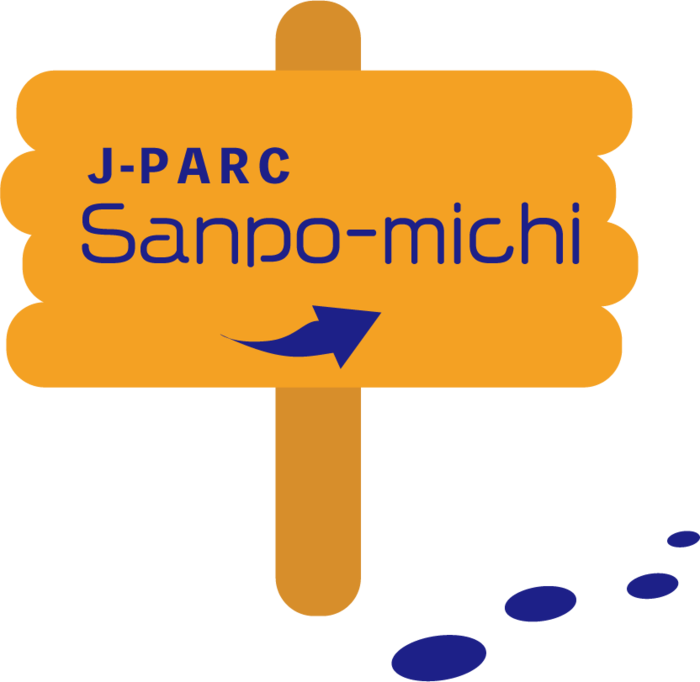
J-PARC's huge accelerator tunnel sits ten and several meters underground at the Nuclear Science Research Institute, and in the tunnel, many protons are running. Outside, on the other hand, many people are enjoying their runs during their lunch break.
Those runners run on the expansive grounds, while enjoying solitude, competing with others, or encouraging each other.
In spring, when runners pass by, petals of wild cherry blossoms accumulated on the road soar lightly as if chasing the runners. In summer, sea breezes from the Pacific Ocean gently stroke the runners' cheeks in intense sunlight after running through 330m-long shade of the LINAC Building. When the runners with long shadows swing ears of Japanese pampas grass on the roadside, autumn insects at their feet stop chirping and see them off. In winter, when animals are absent, the runners’ footsteps echo high and, under the blue sky, resonate with sound of waves leaping over trees.
Minoru Owada is one of the runners, who has been running in this area for over 40 years. Recently, this veteran runner completed running 246 km from Athens to Sparta in Greece in 34 hours 4 minutes 21 seconds. He runs 5,000 km in a year.
Protons at J-PARC continue to run on rainy days, windy days, and snowy days, except for maintenance days. Outside, runners also continue to run on rainy, windy, and snowy days. Their refreshing runs seem to speak for invisible and silent proton’s running.

